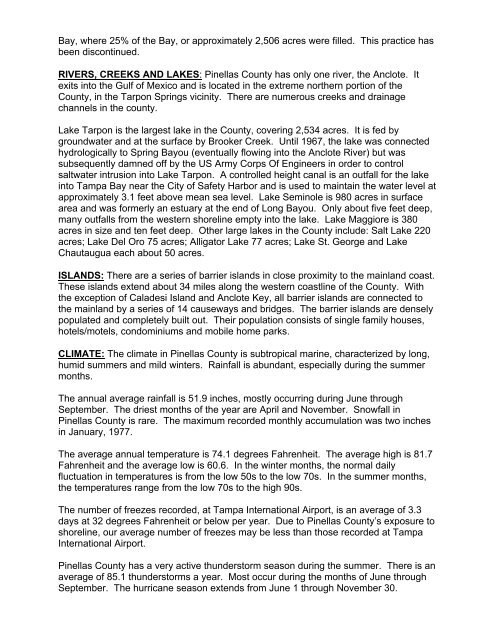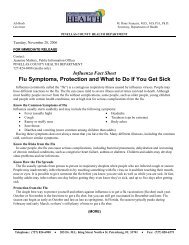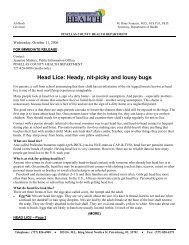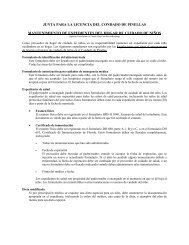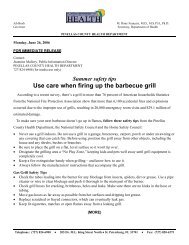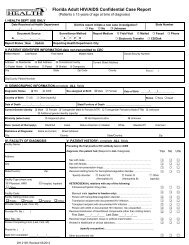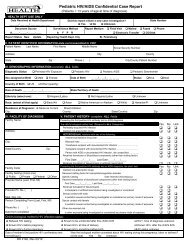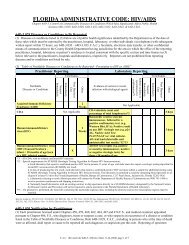Pinellas County Hazard Identification and Vulnerability Assessment
Pinellas County Hazard Identification and Vulnerability Assessment
Pinellas County Hazard Identification and Vulnerability Assessment
You also want an ePaper? Increase the reach of your titles
YUMPU automatically turns print PDFs into web optimized ePapers that Google loves.
Bay, where 25% of the Bay, or approximately 2,506 acres were filled. This practice has<br />
been discontinued.<br />
RIVERS, CREEKS AND LAKES: <strong>Pinellas</strong> <strong>County</strong> has only one river, the Anclote. It<br />
exits into the Gulf of Mexico <strong>and</strong> is located in the extreme northern portion of the<br />
<strong>County</strong>, in the Tarpon Springs vicinity. There are numerous creeks <strong>and</strong> drainage<br />
channels in the county.<br />
Lake Tarpon is the largest lake in the <strong>County</strong>, covering 2,534 acres. It is fed by<br />
groundwater <strong>and</strong> at the surface by Brooker Creek. Until 1967, the lake was connected<br />
hydrologically to Spring Bayou (eventually flowing into the Anclote River) but was<br />
subsequently damned off by the US Army Corps Of Engineers in order to control<br />
saltwater intrusion into Lake Tarpon. A controlled height canal is an outfall for the lake<br />
into Tampa Bay near the City of Safety Harbor <strong>and</strong> is used to maintain the water level at<br />
approximately 3.1 feet above mean sea level. Lake Seminole is 980 acres in surface<br />
area <strong>and</strong> was formerly an estuary at the end of Long Bayou. Only about five feet deep,<br />
many outfalls from the western shoreline empty into the lake. Lake Maggiore is 380<br />
acres in size <strong>and</strong> ten feet deep. Other large lakes in the <strong>County</strong> include: Salt Lake 220<br />
acres; Lake Del Oro 75 acres; Alligator Lake 77 acres; Lake St. George <strong>and</strong> Lake<br />
Chautaugua each about 50 acres.<br />
ISLANDS: There are a series of barrier isl<strong>and</strong>s in close proximity to the mainl<strong>and</strong> coast.<br />
These isl<strong>and</strong>s extend about 34 miles along the western coastline of the <strong>County</strong>. With<br />
the exception of Caladesi Isl<strong>and</strong> <strong>and</strong> Anclote Key, all barrier isl<strong>and</strong>s are connected to<br />
the mainl<strong>and</strong> by a series of 14 causeways <strong>and</strong> bridges. The barrier isl<strong>and</strong>s are densely<br />
populated <strong>and</strong> completely built out. Their population consists of single family houses,<br />
hotels/motels, condominiums <strong>and</strong> mobile home parks.<br />
CLIMATE: The climate in <strong>Pinellas</strong> <strong>County</strong> is subtropical marine, characterized by long,<br />
humid summers <strong>and</strong> mild winters. Rainfall is abundant, especially during the summer<br />
months.<br />
The annual average rainfall is 51.9 inches, mostly occurring during June through<br />
September. The driest months of the year are April <strong>and</strong> November. Snowfall in<br />
<strong>Pinellas</strong> <strong>County</strong> is rare. The maximum recorded monthly accumulation was two inches<br />
in January, 1977.<br />
The average annual temperature is 74.1 degrees Fahrenheit. The average high is 81.7<br />
Fahrenheit <strong>and</strong> the average low is 60.6. In the winter months, the normal daily<br />
fluctuation in temperatures is from the low 50s to the low 70s. In the summer months,<br />
the temperatures range from the low 70s to the high 90s.<br />
The number of freezes recorded, at Tampa International Airport, is an average of 3.3<br />
days at 32 degrees Fahrenheit or below per year. Due to <strong>Pinellas</strong> <strong>County</strong>’s exposure to<br />
shoreline, our average number of freezes may be less than those recorded at Tampa<br />
International Airport.<br />
<strong>Pinellas</strong> <strong>County</strong> has a very active thunderstorm season during the summer. There is an<br />
average of 85.1 thunderstorms a year. Most occur during the months of June through<br />
September. The hurricane season extends from June 1 through November 30.


